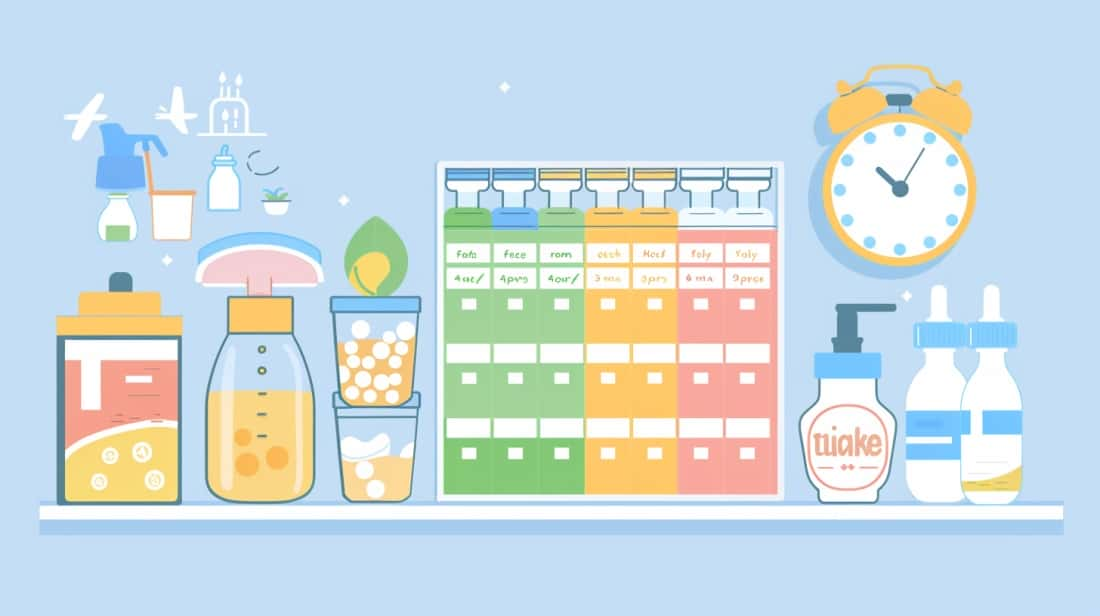When it comes to feeding formula to newborns, understanding the intricacies of determining the right amount for our little ones is essential. Finding the perfect balance between ensuring they get proper nutrition and not overfeeding them is a delicate balancing act. There are several factors to consider carefully when deciding on the correct quantity of formula for a newborn.
How can we make certain we are meeting our baby's needs without overwhelming their delicate systems? Let's explore the nuanced guidelines that can help us navigate this essential aspect of infant care with confidence and precision.
Key Takeaways
- Start with 1-2 ounces every 2-3 hours, adjusting as the newborn grows.
- Monitor weight gain and diaper output for sufficient intake.
- Recognize feeding cues like lip smacking and rooting.
- Maintain hygiene, follow feeding guidelines, and seek professional advice when needed.
Newborn Formula Feeding Guidelines
When determining newborn formula feeding guidelines, it's important to take into account the infant's age, weight, and individual needs to guarantee proper nourishment and growth. Infants typically need to be fed often, starting with 1 to 2 ounces of formula every 2 to 3 hours. This frequent feeding schedule ensures that the baby receives the necessary nutrients and hydration for healthy development. Most newborns feed approximately 8 to 12 times in a 24-hour period. As the infant grows, the feeding amounts can be gradually increased to 2 to 3 ounces every 3 to 4 hours.
Monitoring the baby's weight gain and diaper output is critical in determining if they're receiving enough formula. Consulting with a healthcare provider for guidance on the infant's formula intake and growth is highly recommended to ensure best feeding practices. By following these guidelines and adjusting the feeding amounts based on the infant's needs, caregivers can provide the best possible nourishment for their newborn.
Feeding Amounts for Newborns

To establish proper nourishment and growth for newborns, it's important to determine appropriate feeding amounts based on their age, weight, and individual needs. When it comes to feeding newborns, especially formula-fed babies, here are some key points to take into account:
- Start with 1 to 2 ounces of formula every 2 to 3 hours to meet their nutritional needs.
- Most newborns feed around 8 to 12 times in a 24-hour period, gradually increasing their intake as they grow.
- Monitor your newborn's weight gain and overall satisfaction after feedings to make sure they're getting enough formula.
- Look out for signs of adequate formula intake such as steady weight gain, contentment after feedings, and producing 5-6 wet diapers daily.
- Remember that babies self-regulate their feeding, so avoid encouraging them to finish every bottle and pay attention to their hunger cues.
Formula Feeding Chart for Babies
For ideal feeding guidance for babies, consider referring to a formula feeding chart to determine appropriate amounts at different stages of their growth and development. A formula feeding chart typically recommends offering 1 to 2 ounces of formula every 2-3 hours for newborns. As babies grow, this amount can be adjusted to 2 to 3 ounces every 3-4 hours.
Monitoring formula intake according to the chart suggests offering about 2.5 ounces of formula per pound of body weight daily. As babies reach 8 months to 1 year, they may require 7 to 8 ounces per bottle, 3-4 times daily. When shifting to cow's milk after the first year, it's advised to limit intake to 16-24 ounces daily.
Following a formula feeding chart can provide a structured approach to make sure your baby is receiving the appropriate amount of nutrition tailored to their age and needs.
Recognizing Feeding Cues in Infants

Recognizing feeding cues in infants involves observing subtle signs such as smacking lips, sucking on fists, or turning towards the bottle to make sure timely and adequate nutrition for your baby. It's essential to pay attention to these early signs of hunger as crying is a late cue, signaling that the infant is already quite hungry.
Here are some key cues to watch for:
- Smacking lips or making sucking motions
- Sucking on fists or fingers
- Turning head towards the bottle or breast
- Fussiness or restlessness
- Rooting or trying to latch onto something
Tips for Successful Formula Feeding
When preparing formula for your baby, always confirm the correct ratio of formula to water as per the manufacturer's instructions to provide the best nutrition.
Using clean, sterilized bottles and nipples is vital to prevent contamination and guarantee your baby's health.
Keep an eye on your baby's weight gain, diaper output, and overall satisfaction to determine if they're getting enough formula.
Following a consistent feeding schedule that aligns with your baby's needs is necessary.
Avoid adding cereal or other substances to the formula without consulting a healthcare provider, as this can impact your baby's digestion.
If you encounter any feeding difficulties or have concerns about the amount your baby is consuming, don't hesitate to seek guidance from a pediatrician.
Monitoring these factors diligently will help you achieve successful formula feeding and make sure your baby is receiving the nutrition they require.
Frequently Asked Questions
How Much Formula Should I Feed My Newborn Chart?
We aim to feed our newborns the right amount of formula by following guidelines based on their weight and age. Ensuring they have frequent, appropriate-sized feedings helps them grow healthy and strong. It's crucial to monitor their progress closely.
How Do I Calculate Formula Feeding for My Baby?
We calculate formula feeding for our baby by offering 2.5 ounces per pound of their body weight daily. Adjust amounts based on hunger cues and growth. Monitor weight gain and diaper output, ensuring not to exceed 32 ounces in 24 hours.
How Many Ml Should a Newborn Drink Calculator?
We determine a newborn's formula intake by observing their hunger cues, not just a rigid calculator. Babies communicate their needs uniquely. Trust them while also following general guidelines and seek professional advice for assurance.
How Many Scoops of Formula Should a Newborn Have?
We typically give our newborn 1 scoop of formula powder mixed with 2 ounces of water per feeding. The exact number of scoops might vary based on the formula brand and concentration level, so we always stick to the manufacturer's guidelines.
Conclusion
In summary, following the thorough guidelines outlined in 'Newborn Formula Feeding Amount: A Complete Guide' will help parents guarantee their baby receives the proper nutrition for healthy growth and development.
By monitoring formula intake, recognizing feeding cues, and following recommended feeding amounts, parents can support their baby's individualized feeding needs.
Remember, a well-fed baby is a happy and healthy baby.










